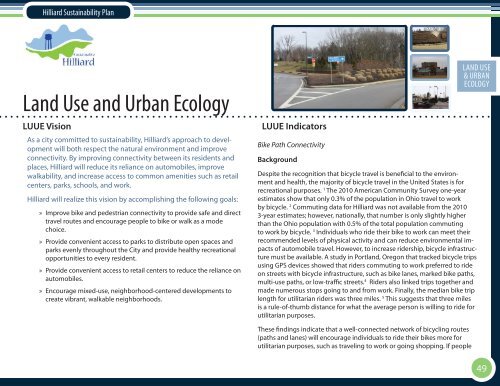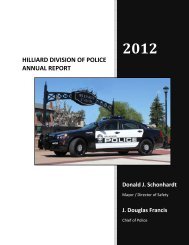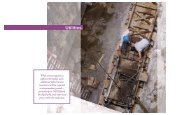The City of Hilliard Sustainability Plan
The City of Hilliard Sustainability Plan
The City of Hilliard Sustainability Plan
Create successful ePaper yourself
Turn your PDF publications into a flip-book with our unique Google optimized e-Paper software.
<strong>Hilliard</strong> <strong>Sustainability</strong> <strong>Plan</strong>Land Use and Urban EcologyLUUE VisionAs a city committed to sustainability, <strong>Hilliard</strong>’s approach to developmentwill both respect the natural environment and improveconnectivity. By improving connectivity between its residents andplaces, <strong>Hilliard</strong> will reduce its reliance on automobiles, improvewalkability, and increase access to common amenities such as retailcenters, parks, schools, and work.<strong>Hilliard</strong> will realize this vision by accomplishing the following goals:» Improve bike and pedestrian connectivity to provide safe and directtravel routes and encourage people to bike or walk as a modechoice.» Provide convenient access to parks to distribute open spaces andparks evenly throughout the <strong>City</strong> and provide healthy recreationalopportunities to every resident.» Provide convenient access to retail centers to reduce the reliance onautomobiles.» Encourage mixed-use, neighborhood-centered developments tocreate vibrant, walkable neighborhoods.LUUE IndicatorsBike Path ConnectivityBackgroundLAND USE& URBANECOLOGYDespite the recognition that bicycle travel is beneficial to the environmentand health, the majority <strong>of</strong> bicycle travel in the United States is forrecreational purposes. 1 <strong>The</strong> 2010 American Community Survey one-yearestimates show that only 0.3% <strong>of</strong> the population in Ohio travel to workby bicycle. 2 Commuting data for <strong>Hilliard</strong> was not available from the 20103-year estimates; however, nationally, that number is only slightly higherthan the Ohio population with 0.5% <strong>of</strong> the total population commutingto work by bicycle. 3 Individuals who ride their bike to work can meet theirrecommended levels <strong>of</strong> physical activity and can reduce environmental impacts<strong>of</strong> automobile travel. However, to increase ridership, bicycle infrastructuremust be available. A study in Portland, Oregon that tracked bicycle tripsusing GPS devices showed that riders commuting to work preferred to rideon streets with bicycle infrastructure, such as bike lanes, marked bike paths,multi-use paths, or low-traffic streets. 4 Riders also linked trips together andmade numerous stops going to and from work. Finally, the median bike triplength for utilitarian riders was three miles. 5 This suggests that three milesis a rule-<strong>of</strong>-thumb distance for what the average person is willing to ride forutilitarian purposes.<strong>The</strong>se findings indicate that a well-connected network <strong>of</strong> bicycling routes(paths and lanes) will encourage individuals to ride their bikes more forutilitarian purposes, such as traveling to work or going shopping. If people49






